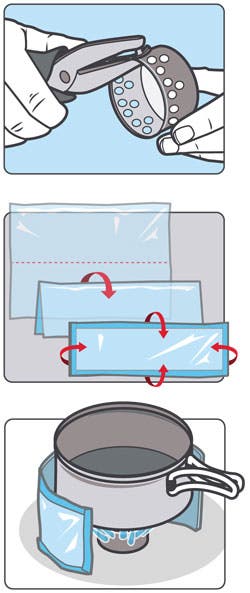Build It: Make an Efficient Alcohol Stove

'alcohol stove illo 200x170'
Steps
1. Use the blunt end of a knife to flatten the sharp edge of the clean, empty cat food can.
2. Punch holes all the way around the can, just below the rim (about ¹⁄8 inch apart).
3. Make a second row of holes below the first, aligning one between every other ¹⁄8-inch gap (A).
4. Fashion a windscreen out of aluminum foil (B). Cut a length of foil that’s three inches longer than your pot’s circumference and fold it in half lengthwise. Fold the edges (about 1/2 inch) to improve durability.
5. Add an ounce of denatured alcohol (paint thinner is one example, but inexpensive variations are available at gas stations and hardware and grocery stores) to the can, light it (you may not see much of a flame), set your pot (use one with a diameter about twice that of the can) directly on top of it, and wrap the windscreen around (C). It may take the stove a minute to burn at full power (alcohol is efficient, but it’s slower than pressurized fuel).
Bonus: About one ounce of fuel ($0.20) will boil two cups of water—so the savings on canister fuel ($0.70+/ounce) will add up quickly.
Materials
» 3-ounce cat food can (Skurka likes Fancy Feast)
» 1-hole punch (a craft model allows a farther reach)
» aluminum foil
» denatured alcohol

For a video demo showing how to make and use an alcohol stove, visit backpacker.com/alcoholstove.